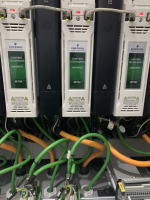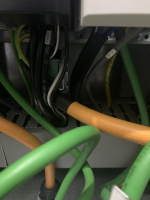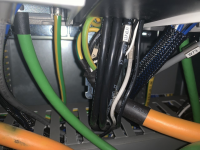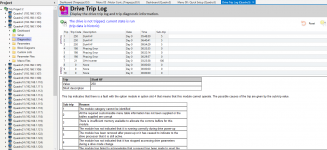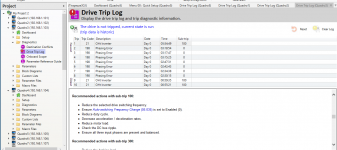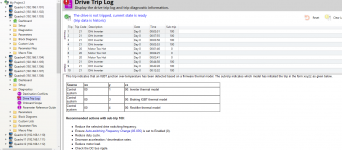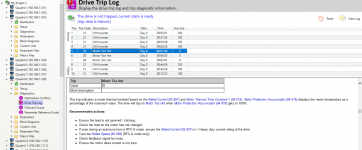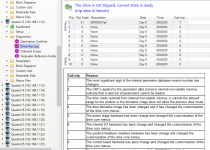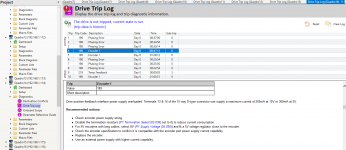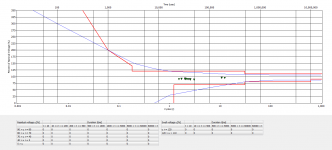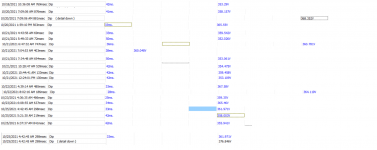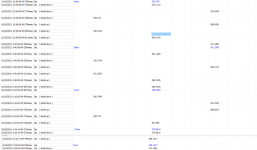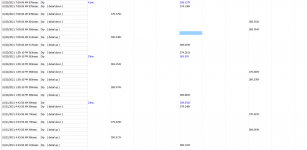You are using an out of date browser. It may not display this or other websites correctly.
You should upgrade or use an alternative browser.
You should upgrade or use an alternative browser.
Troublesome electrical issues
- Thread starter cpedersen
- Start date
- Status
- Not open for further replies.
The orange cable is the drive cable to the motor. It's shielded and the shield attaches to a special clamp at the drive. If that connection is loose or not made right, and the motor has an encoder cable on the same path, that one does, the encoder cable shield is paralleled with the orange cable shield. The encoder cable, green one, can get noisy if the orange cable has a bad shield connection. That's one of the faults it's throwing, noisy encoder.
Some points:
- these same errors are occurring on multiple drives. About 1/3 of all drives have no errors. The remaining have multiple iterations of the errors listed above.
- drives 1-21 are in use. Drives 22-28 are never used, (duty cycle of 0); the errors occur even though the drive is not used.
- cannot disable the unused drives.
- All the drives have identical programming, and roughly identical loading. The duty cycle is roughly 16% for most drives. For 4 drives it is 50%. Three of the drives at 50% never give a problem. The other throws errors with the same frequency as other drives. This suggests it isn't load related.
- I can hear relays chattering on and off about 2-3 times per day. A typical chatter session will last 2-5 seconds and will trip the relay 20 times in that period.
Yes, I concur on the cabling parallelling being an issue. I can't do anything about that one without a lot of work. But I will check both grounds on the cable with the faulty encoder info. Thank youThe orange cable is the drive cable to the motor. It's shielded and the shield attaches to a special clamp at the drive. If that connection is loose or not made right, and the motor has an encoder cable on the same path, that one does, the encoder cable shield is paralleled with the orange cable shield. The encoder cable, green one, can get noisy if the orange cable has a bad shield connection. That's one of the faults it's throwing, noisy encoder.
So we have a piece of equipment that requires 310 amps at 400 V. It is the only piece of equipment on the circuit.
The primary side is supplied by the utility with 240 nominal high leg delta. The transformer is a 225 KVA delta / Wye transformer.
The secondary side is 400 volts WYE. No neutral has been brought to the equipment only three hots and a ground.
The equipment has 30 VFD's with low duty cycles, each rated at 30 Amps. Peak current (200ms) has been 120Amps on each leg.
I have monitored the power for the last month. During this time in operation we consistently get the ground showing intermittent 5.5V. Also current, but I cannot recollect amount (an amp or two?) Internal to equipment there is a transformer 400/24 transformer. The VFDs are fed by a power supply, measuring from the VFD to the ground bar, I show 45 ohms while running. The metal case (also supposedly grounded to the bar) only shows 2.6 Ohms.
Total harmonic distortion (current) ranges from 45-70% - which I think contribute to the voltage on the ground.
When turning on, random VFD's will trip going into error conditions. This goes on for about 45-135 minutes. After which the equipment runs all day without incident.
Random problems always brings to mind grounding issues.
I suspect that the voltage on the ground is causing the trips.
Question: What avenue would you attack this?
1). Bring a neutral, with the idea that this would allow us to cleanup the ground? (Does that even make sense?)
2). Install line reactors, with the idea that lowering the harmonic distortion by 10% would result in less voltage on the ground.
3). Same argument as #2, except active filtering would lower the distortion down to 5-8%. (much more expensive).
4). Something else?
Appreciate the thoughts
Ok so chances are those are diode front end VFDs which typically have some pretty awful line performance. A line reactor blocks triplen harmonics but those aren’t the harmonics tge VFDs create so that is a waste of time. Essentially you have been given bad advice. Current harmonics are HARMLESS unless it’s affecting the transformer. Look at it this way. You have a 225 kVA transformer. If the load is purely sinusoidal then the usual rating system works. But it’s not. With harmonics there are times where you are drawing more current than simple sine wave math predicts. If the transformer load is below the rated current then it won’t distort the output. If it’s above the rated current voltage starts to drop and the more you exceed the rating the more the output sags. If this happens you get voltage harmonics, which is NOT harmless and what we need to avoid.
Where there are issues is two things. First off the transformer short circuit rating is pretty close to what I suspect the VFDs are rated for. So unless they have fast fuse protection or something like that you’ll get a lot of VFD failures where something as simple as a motor failure causes a VFD to fail. This is where a 3% line reactor or splitting them up among multiple transformers can make a difference and leads to what is probably your issue.
So I don’t know the ratings and how it’s timed but I’m estimating 21 kVA each? 400 x 30 x 1.732 is 21 kVA. At 30 drives that’s 630 kVA. I’m not so concerned about operational issues when it’s running as you said that seems OK. But when all those drives initially power up you have every drive trying to precharge simultaneously. I have serious concerns you’ll get all kinds of boot up glitches as the line voltage takes a dump when this occurs, which is what you describe. A simple test is hook up your meter on alligator clips and watch line voltage (phase to phase) looking for minimum voltage. I’ll bet it’s dipping low causing momentary power losses causing malfunctions in the electronics (think intermittent power failures to 30 tiny computers). A better strategy is to power them up in stages. Often machine builders neglect this or feel you should just leave it powered up 24x7 and reboot a few as needed. A 1500 kVA transformer would do much better but again cause even worse short circuit issues. So you can use contactors and possibly power things up in stages with timers/PLC logic or get more smaller transformers.
Right, I was reading about a device that delays start up, as an alternate to a line reactor.Ok so chances are those are diode front end VFDs which typically have some pretty awful line performance. A line reactor blocks triplen harmonics but those aren’t the harmonics tge VFDs create so that is a waste of time. Essentially you have been given bad advice. Current harmonics are HARMLESS unless it’s affecting the transformer. Look at it this way. You have a 225 kVA transformer. If the load is purely sinusoidal then the usual rating system works. But it’s not. With harmonics there are times where you are drawing more current than simple sine wave math predicts. If the transformer load is below the rated current then it won’t distort the output. If it’s above the rated current voltage starts to drop and the more you exceed the rating the more the output sags. If this happens you get voltage harmonics, which is NOT harmless and what we need to avoid.
Where there are issues is two things. First off the transformer short circuit rating is pretty close to what I suspect the VFDs are rated for. So unless they have fast fuse protection or something like that you’ll get a lot of VFD failures where something as simple as a motor failure causes a VFD to fail. This is where a 3% line reactor or splitting them up among multiple transformers can make a difference and leads to what is probably your issue.
So I don’t know the ratings and how it’s timed but I’m estimating 21 kVA each? 400 x 30 x 1.732 is 21 kVA. At 30 drives that’s 630 kVA. I’m not so concerned about operational issues when it’s running as you said that seems OK. But when all those drives initially power up you have every drive trying to precharge simultaneously. I have serious concerns you’ll get all kinds of boot up glitches as the line voltage takes a dump when this occurs, which is what you describe. A simple test is hook up your meter on alligator clips and watch line voltage (phase to phase) looking for minimum voltage. I’ll bet it’s dipping low causing momentary power losses causing malfunctions in the electronics (think intermittent power failures to 30 tiny computers). A better strategy is to power them up in stages. Often machine builders neglect this or feel you should just leave it powered up 24x7 and reboot a few as needed. A 1500 kVA transformer would do much better but again cause even worse short circuit issues. So you can use contactors and possibly power things up in stages with timers/PLC logic or get more smaller transformers.
Speaking empirically, we seem to get two kinds of errors - one where we can press reset on the drive and the drive resets and we're good to go. And the other where the drive seems to trip, resetting it will not restore and the only option is to power down, power up.
I have monitored THD-V as well - they seem stable between 2-4%.
I have been told that the transformer is undersized by one electrical engineer (out of three). I have been told that that we do have fast fuse protection on the components but I haven't verified.
In any given week we have call it 12-20 dips in the range of 80-90% power, I'll upload a couple of representative ITEC curves.
I didn't understand your comment about a 1500 KVA transformer causing bigger short circuit issues. Could you elaborate?
I have seen peak power at 1200 Amps or so, with 200 ms power at 700 Amps or so.
These were the soft starters I was looking at
However, I am not certain that current harmonics are not relevant, as the fluke reports power factors of 45%, which is significantly less than the 80% target, although not surprising I'm told for a lightly loaded vfd.
However, I am not certain that current harmonics are not relevant, as the fluke reports power factors of 45%, which is significantly less than the 80% target, although not surprising I'm told for a lightly loaded vfd.
The only issue here with the power dip log is that I can there is only partial line up between our power turn on and the microdips.
Showing inrush:


You have the information and can report to whomever that the voltage levels are normal and the loads are non-linear and create over 20% THD.
Also when you start up the motors (Inrush) that causes a dip in the voltage which is over 10% of the normal level.
Showing inrush:


You have the information and can report to whomever that the voltage levels are normal and the loads are non-linear and create over 20% THD.
Also when you start up the motors (Inrush) that causes a dip in the voltage which is over 10% of the normal level.
Last edited:
So our power utility consistently bumps along at the bare minimum of voltage - 113.98 volts on a 120 line, for example. Additionally, they have said that many of the microoutages might be on their side as a result of an undersized transformer.
So my corrective actions so far
1. Work with the utility to replace upgrade pole transformers.
2. Upsize ground wires and rebond to ground rods.
3. Check and bond the grounds on the drive cables.
4. Look into easy start components to introduce between before the power supplies.
5. Investigating upsizing the 240/400 transformer.
6. After grounding investigate via Emerson's on board scope to see if DC ripple is occuring
7. Ensure The secondary Y is separately derived and has a GEC to the ground rod (#6 max to the ground rod may meet code idk). The transformer secondary has a system bonding jumper that connects the neutral, the GEC, all other Earth ground systems nearby, the building steel, and the equipment grounding system.
8. Start to panic !
9. Investigate EMC filters
10. Investigate Line reactor(s).
Sound about right?
So my corrective actions so far
1. Work with the utility to replace upgrade pole transformers.
2. Upsize ground wires and rebond to ground rods.
3. Check and bond the grounds on the drive cables.
4. Look into easy start components to introduce between before the power supplies.
5. Investigating upsizing the 240/400 transformer.
6. After grounding investigate via Emerson's on board scope to see if DC ripple is occuring
7. Ensure The secondary Y is separately derived and has a GEC to the ground rod (#6 max to the ground rod may meet code idk). The transformer secondary has a system bonding jumper that connects the neutral, the GEC, all other Earth ground systems nearby, the building steel, and the equipment grounding system.
8. Start to panic !
9. Investigate EMC filters
10. Investigate Line reactor(s).
Sound about right?
If the utlity is always low, and balanced, they may be able to do a tap change. For the times when they go intermittantly out, the drive is probably behaving well when tripping for phase loss. If you know the drives trip for utility brown outs, there may be an easier way to reset them.
Thermal scanning would be on the list if you want to look at everything.
Thermal scanning would be on the list if you want to look at everything.
synchro
Senior Member
- Location
- Chicago, IL
- Occupation
- EE
Some points:
- these same errors are occurring on multiple drives. About 1/3 of all drives have no errors. The remaining have multiple iterations of the errors listed above.
- drives 1-21 are in use. Drives 22-28 are never used, (duty cycle of 0); the errors occur even though the drive is not used.
- cannot disable the unused drives.
- ...
Are most of the unused drives the larger ones in the 27A - 32A range that you have mentioned? If so, then what would you think about doing the following:
Remove the fuses on one of the unused drives and see if the machine eventually recovers on power-up like it normally does. Then if it works OK you could progress to removing the fuses on the other unused drives, possibly one drive at a time.
If all of the unused drives can be disabled with the machine still functional, then that should reduce the amount of peak current when the drives could be in precharge simultaneously as paulengr has pointed out. Whether that would be sufficient is another matter.
- Status
- Not open for further replies.

